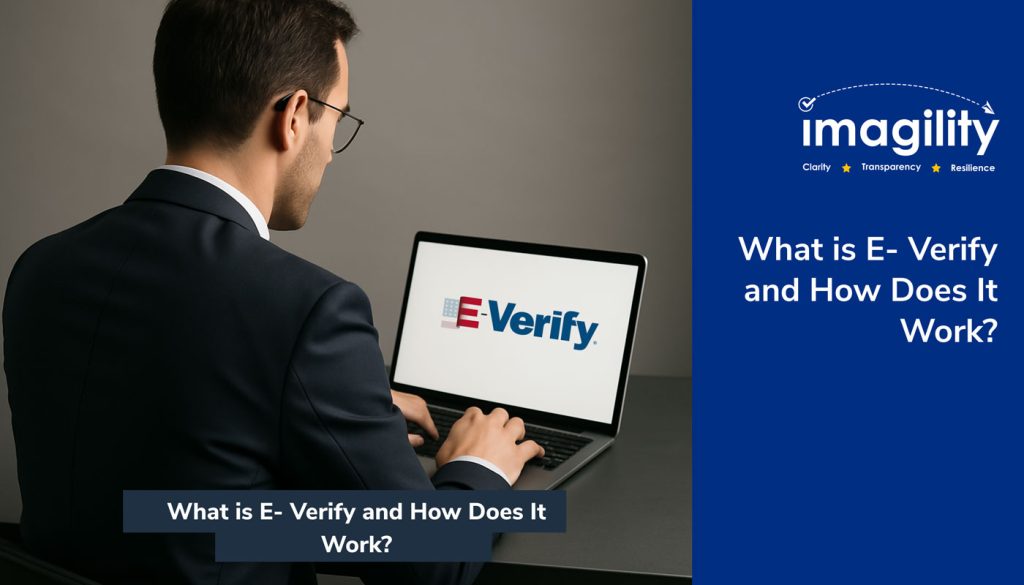Hiring legally authorized employees is a big challenge, and E-verify, a web-based system operated by DHS, helps employers overcome this challenge. It allows employers to electronically confirm that newly hired employees are authorized to work in the United States.
Unlike the traditional I-9 verification process that relies solely on document review, E-Verify provides real-time confirmation, helping employers avoid hiring unauthorized workers and reducing the risk of penalties.
Whether you are required to use E-Verify or want to strengthen your hiring practices, understanding how the E-verify system works is essential for protecting your business and building a lawful workforce.
Here we go!
What is E-Verify?
E-Verify is an online system designed to help employers confirm the employment eligibility of their new hires. It’s operated by the U.S. Department of Homeland Security (DHS) in partnership with the Social Security Administration (SSA).
The system works by electronically comparing information from an employee’s Form I-9, such as their name, date of birth, and Social Security number, against federal government records.
If the information matches, the employee is confirmed as authorized to work. If not, the system flags the issue so it can be resolved. This added step gives employers more confidence in their hiring process and helps ensure compliance with federal employment laws.
How Does E-Verify Work?
E-Verify integrates directly into your hiring process following the completion of the Form I-9. Here’s how it works:
- Employee Completes Form I-9
The employee provides identity and work authorization documents, and the employer completes Section 2.
- Employer Submits Information to E-Verify
The employer enters relevant details from the I-9 into the E-Verify system.
- System Cross-Checks Against Federal Databases
E-Verify verifies the information against DHS and SSA records.
- Receive Verification Results
In most cases, E-Verify returns results within seconds. The system will indicate:
- Employment Authorized: The employee is confirmed eligible.
- Tentative Nonconfirmation (TNC): There is a mismatch. The employee can take steps to resolve it.
- Final Nonconfirmation: The issue was not resolved in time, and the employee is not authorized to work.
Is E-Verify Mandatory for All U.S. Employers?
No, E-Verify is not mandatory for all employers, but some are required to use it. Most private employers are not legally required to use E-Verify. However, there are important exceptions:
- Federal contractors and subcontractors must use E-Verify if their contract includes the E-Verify clause.
- Certain states require some or all employers to use E-Verify by law. For example, states like Alabama, Arizona, Florida, and South Carolina have E-Verify mandates in place.
- Employers with specific visa sponsorship requirements (such as H-1B or STEM OPT extensions) may choose to use E-Verify to meet program rules.
- Even if it is not required, many employers voluntarily use E-Verify as a best practice to reduce the risk of hiring unauthorized workers, avoid costly penalties, and strengthen their compliance program.
What Does E-Verify Mean for Employers and Employees?
E-Verify plays a key role in helping both employers and employees navigate the hiring process with compliance.
For Employers
Using E-Verify brings several benefits:
- Better Compliance
It adds an extra layer of protection by verifying employee work eligibility directly with federal records.
- Lower Risk of Penalties
E-Verify helps detect errors or false information early, reducing the chances of government fines or audits.
- More Confidence in Hiring
Employers can be more certain that new hires are legally authorized to work, which supports long-term workforce stability.
- Improved Audit Readiness
E-Verify records can be used to back up your I-9 documentation if your company faces an inspection.
For Employees
E-Verify protects employees in several ways:
- Fairness and Transparency
All employees are verified using the same system, reducing the risk of discrimination.
- Right to Resolve Issues
If an employee’s information does not match government records (a Tentative Nonconfirmation or TNC), they are notified and given a chance to correct it.
- Job Protection During Disputes
Employers can not take action against an employee while a TNC is being resolved, ensuring fairness during the process.
Final Thoughts
E-Verify is a valuable tool for U.S. employers looking to simplify employment eligibility verification and reduce the risk of compliance violations. E-Verify creates a safer, more reliable hiring experience for everyone involved.
When used correctly, it supports legal hiring, reduces risk, and builds trust between employers and their workforce. With tools like Imagility, employers can take this a step further by integrating I-9 completion, E-Verify submission, video document verification, and real-time compliance tracking, all in one innovative platform.
Ready to streamline your I-9 and E-Verify process? Book a free demo.










